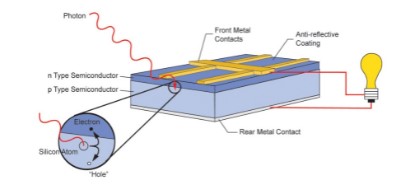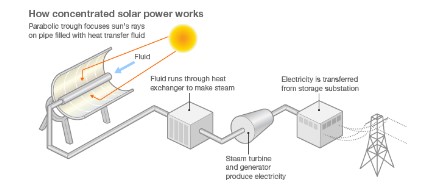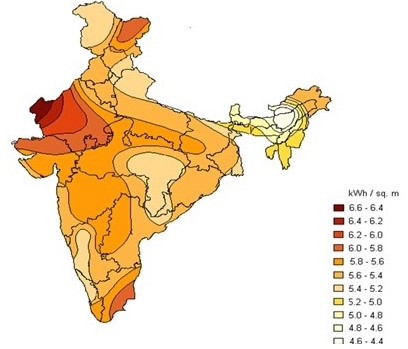Solar Power Sector In India
2022 MAR 23
Mains >
Environment & Ecology > Global warming > Renewable energy
WHY IN NEWS?
- India added a record 10 Gigawatt (GW) of solar energy to its cumulative installed capacity in 2021.
- This has been the highest 12-month capacity addition, recording nearly a 200% year-on-year growth.
- India has now surpassed 50 GW of cumulative installed solar capacity, as on 28 February 2022.
SOLAR POWER:
- Solar power is the conversion of energy from sunlight into electricity, either directly using photovoltaics (PV), indirectly using concentrated power or a combination of both.
- Photovoltaic cells:
- A solar cell, or photovoltaic cell (PV), is a device that converts light into electric current using the photovoltaic effect.
- They produce direct current (DC) power which fluctuates with the sunlight's intensity.
- An array of PV cells is connected inside modules to form arrays to produces power at the desired electricity.

- Concentrated solar power:
- Also called concentrated solar thermal, they use lenses or mirrors and tracking systems to concentrate sunlight and use the resulting heat to generate electricity to run conventional steam-driven turbines.

INDIA’S SOLAR POTENTIAL:
- India is endowed with vast solar energy potential. About 5,000 trillion kWh per year energy is incident over India's land area with most parts receiving 4-7 kWh per sq. m per day.
- National Institute of Solar Energy has assessed the country’s solar potential of about 748 GW.
??????? ???????
???????
INDIA’S TARGETS:
- India has set a target of installing of installing 175 GW of renewable energy capacity by the year 2022, which includes 100 GW from solar, 60 GW from wind, 10 GW from bio-power and 5 GW from small hydro-power.
- At the COP26 India is committed to achieving 500 GW of installed electricity capacity from non-fossil fuel sources by the year 2030, of which 300 GW is expected to come from solar power.
INSTITUTIONAL MECHANISMS:
- Ministry of New and Renewable Energy (MNRE):
- MNRE is the nodal Ministry for all matters relating to new and renewable energy.
- The broad aim of the Ministry is to develop and deploy new and renewable energy to supplement the energy requirements of the country.
- National Institute of Solar Energy (NISE):
- NISE, an autonomous institution of Ministry of New and Renewable Energy (MNRE), is the apex National R&D institution in the field Solar Energy.
- It is an effective interface between the Government and institutions, industry & user organizations for development, promotion and widespread utilization of solar energy in the country.
- The institute is involved in demonstration, standardization, interactive research, training and testing solar technologies and systems.
- Solar Energy Corporation of India:
- It is a company of the Ministry of New and Renewable Energy, established to facilitate the implementation of the National Solar Mission.
- It is the only Central Public Sector Undertaking (PSU) dedicated to the solar energy sector.
- The company's mandate has been broadened to cover the entire renewable energy domain and the company will be renamed to Renewable Energy Corporation of India (RECI).
MAJOR INITIATIVES:
- National Solar Mission (NSM):
- Launched as the Jawaharlal Nehru National Solar Mission in 2010, the mission seeks to establish India as a global leader in solar energy, by creating the policy conditions for its diffusion across the country.
- The mission's original target was achieving 20 gigawatts (GW) of grid-connected solar power plants.
- In 2014, the government revised the target to 100 GW by 2022:
- 60 GW from ground-mounted large solar power plants
- 40 GW from rooftop solar power plants.
- The mission is one of the key components of the National Action Plan on Climate Change.
- International Solar Alliance (ISA):
- ISA is conceived as a coalition of solar-resource-rich countries (which lie either completely or partly between the Tropic of Cancer and the Tropic of Capricorn) to address their special energy needs.
- ISA was launched at the 21st session of UNFCCC conference of Parties (COP-21) in Paris, France.
- ISA is a treaty-based inter-governmental organization. It is headquartered at the NISE campus in Gurugram.
- Global Solar Atlas:
- The alliance has partnered with World Bank to launch Global Solar Atlas, a free, web-based tool to help investors and policymakers identify potential sites for solar power generation anywhere in the world.
- One Sun One World One Grid (OSOWOG):
- The idea was first proposed by Indian Prime Minister during the first assembly of the International Solar Alliance (ISA) in 2018.
- The fundamental concept behind OSOWOS is to develop a transnational grid that will be laid all over the globe to transport the solar power generated across the globe to different load centres.
- Production Linked Incentive (PLI) Scheme
- The Union Cabinet has given its approval to introduce the Production-Linked Incentive (PLI) Scheme in High Efficiency Solar PV Modules for Enhancing India’s Manufacturing Capabilities and Enhancing Exports – Atmanirbhar Bharat.
- National wind-solar hybrid energy policy:
- MNRE adopted the policy to provide a framework for the promotion of large grid-connected wind-solar PV hybrid system for efficient utilization of transmission infrastructure and land.
- The Policy seeks to promote new hybrid projects as well as hybridisation of existing wind/solar projects.
- Scheme for “Development of Solar Parks and Ultra Mega Solar Power Projects”:
- The scheme envisages supporting the States/UTs in setting up solar parks at various locations in the country with a view to create required infrastructure for setting up of solar power projects.
- The capacity of the solar parks shall be 500 MW and above.
- Sustainable Rooftop Implementation for Solar Transfiguration of India (SRISTI)
- It aims to bring DISCOMs to the forefront in the implementation of rooftop solar projects by providing them financial support.
- The distribution companies will act as a nodal agency, provide approval for installation, manage the distribution network and train the manpower.
- Suryamitra scheme:
- It is a skill development program that aims to create skilled manpower in commissioning, installation, O&M of solar power plants and equipment.
- The programme is implemented by National Institute for Solar Energy (NISE).
- Foreign investment:
- In the solar panel manufacturing sector, the Indian government allows 100% foreign investment as equity and it qualifies for automatic approval.
- The government is also encouraging foreign investors to set up renewable energy-based power generation projects on build-own-operate basis.
- Solar off-grid programmes:
- Atal Jyoti Yojana (AJAY):
- MNRE launched the scheme to illuminate dark regions across various states through solar power with high mast solar LED street lights.
- Pradhan Mantri Kisan Urja Suraksha evem Utthan Mahabhiyan (PM KUSUM):
- MNRE launched the PM KUSUM Scheme to incentivise farmers to run solar farm water pumps and use barren land for generating power for extra income.
- The Scheme consists of three components:
- Component A: 10,000 MW of Decentralized Ground Mounted Grid Connected Renewable Power Plants of individual plant size up to 2 MW.
- Component B: Installation of 17.50 lakh standalone Solar Powered Agriculture Pumps of individual pump capacity up to 7.5 HP.
- Component C: Solarisation of 10 Lakh Grid-connected Agriculture Pumps of individual pump capacity up to 7.5 HP.
ACHIEVEMENTS SO FAR:
- India ranks fifth in solar power deployment, contributing nearly 6.5% to the global cumulative capacity of 709.68 GW.
- As on November 2021 The country’s installed Renewable Energy (RE) capacity stands at 151.4 GW:
- Solar: 49 GW
- Wind: 40 GW
- Small hydro Power: 4 GW
- Bio-power: 10 GW
- Large Hydro: 47 GW
- India’s nuclear energy based installed electricity capacity stands at 6.78 GW.
- 45 solar parks of aggregate capacity 37 GW have been approved in India.
- Examples: Solar Parks in Pavagada (2 GW), Kurnool (1 GW) etc.
- The world’s largest renewable energy park of 30 GW capacity solar-wind hybrid project is under installation in Gujarat.
- Solar tariffs have fallen consistently over the past decade to a low of under Rs 2 per unit (1 unit = 1 kWh) in December 2020 due to the falling price of solar panels and lower financing cost.
ADVANTAGES OF SOLAR ENERGY:
- Solar energy is a truly renewable energy source.
- It can be harnessed in almost all areas of the world and is available every day.
- High energy yield:
- Solar energy has ability to live grid free if all power generated provides enough for the home / building
- Pollution free and causes no carbon emissions:
- Solar power is pollution free and causes no greenhouse gases to be emitted after installation
- Low maintenance cost:
- Solar energy conversion equipments have longer life and need lesser maintenance and hence provide higher energy infrastructure security.
DISADVANTAGES OF SOLAR ENERGY:
- Storage is expensive:
- Solar energy has to be used right away, or it can be stored in large batteries.
- These batteries, used in off-the-grid solar systems, can be charged during the day so that the energy is used at night.
- This is a good solution for using solar energy all day long but it is also quite expensive.
- Requires vast area of land:
- The more electricity you want to produce, the more solar panels you will need, as you want to collect as much sunlight as possible.
- Solar PV panels require a lot of land to generate power.
- Environmental concerns:
- Solar waste:
- Used solar cells are a major e-waste, the disposal of which poses serious challenges.
- By the end of 2030, India will likely produce nearly 34,600 metric tonnes of solar PV waste.
- Increase albedo:
- Also, solar plants increase the albedo, thereby affecting the microclimate of the region.
CHALLENGES:
- Contribution of solar energy to the country’s total power generation is still low:
- Despite significant growth in the installed solar capacity, the contribution of solar energy to the country’s power generation has not grown at the same pace.
- In 2019-20, for instance, solar power contributed only 3.6% (50 billion units) of India’s total power generation of 1390 BU.
- Land acquisition:
- Per capita land availability is very low in India.
- However, dedication of land area for exclusive installation of solar cells might have to compete with other necessities that require land such as agriculture.
- Multiple governing agencies:
- Complexity of subsidy structure and involvement of too many agencies like MNRE, IREDA, electricity boards and electricity regulatory commissions makes the development of solar PV projects difficult.
- High capital investments:
- The upfront expense of building and installing solar farms are very high.
- Hence, it is unviable for state-run DISCOMs with fragile financial health to take up such projects.
- Grid connectivity:
- Lack of necessary transmission infrastructure and power storage facilities such as batteries limit the viability of integrating solar power stations with conventional sources.
- Unpredictable government policies:
- Rules, regulations and taxes are imposed without much discussions or warnings.
- Example: The introduction 5% GST on solar panels has forced several under-construction projects to run into troubles of profitability. Also, several states like Andhra Pradesh have been making attempts to renegotiate renewable energy tariffs. This significantly affects the profitability of power plants.
- Unviable tariffs:
- Cut-throat competition among producers is forcing cost of renewables to decline to unsustainable levels.
- Solar energy tariffs in India are among the lowest in the world, but state governments are keen to push them down further.
- Also, as of 2019, state discoms owe a whopping Rs. 9,735.62 crore to renewable energy companies. All of these factors are alienating private investors from solar power.
- Quality of power:
- A new area of concern is the quality of solar energy installations in India.
- Indian developers buy from second-tier or poor-quality Chinese manufacturers who sell modules at cheaper rates.
- These panels degrade quickly and increase cost of production.
- Human resource shortages:
- Shortage of trained technicians for installation, periodic repair and maintenance in acute in India.
- Also, limited academic and research facilities in this field means India will continue to be dependent on import of technology and man power.
- India’s domestic solar module manufacturing capacity is very low:
- Domestic manufacturing capacities in the solar sector do not match up to the present potential demand for solar power in the country.
- Backward integration in the solar value chain is absent as India has no capacity for manufacturing solar wafers and polysilicon.
- In 2021-22, India imported nearly USD 76.62 billion worth solar cells and modules from China alone, accounting for 6% of India’s total imports that year.
- Low manufacturing capacities, coupled with cheaper imports from China have rendered Indian products uncompetitive in the domestic market.
- Import dependency:
- India relies heavily on China for major components such as PV cells.
- Over-reliance on any single foreign country puts Indian solar sector at risk of disruption in supply chain and cripple indigenisation of the sector.
- Low budget allocation to SECI:
- Budget estimate for the Union Ministry of New and Renewable Energy (MNRE) for 2022-23 showed that the investment in Solar Energy Corporation of India (SECI) has been nearly halved — to less than Rs 1,000 crores from over Rs 1,800 crore.
WAY FORWARD:
- Commit more to cleaner energy:
- The pandemic presents a critical opportunity for India to plan a ‘Green Deal’, similar to the lines of what the EU has committed itself to.
- The EU has pledged to stay away from fossil-fueled projects in its COVID-19 recovery strategy.
- Enhancing research and development:
- A primary issue with the manufacturing of solar PhotoVoltaic (PV) modules in India over the years has been a lack of quality.
- This could have been addressed by enhancing research and development related to technological aspects of fully integrated manufacturing units from polysilicon to solar PV modules.
- Better cooperation:
- While the central government has been pushing hard to achieve the 100 GW target, most states and DISCOMs have not shown strong commitment or urgency to meet the goals.
- Unless the central government and states make a coordinated effort, the chances of meeting renewable energy goals are very slim.
- Separate financing:
- Loan basket and loan limit for conventional power sector should be separate from that of renewable energy sector so that the development of this sector does not get affected due to the prevalence of NPAs in the conventional power sector.
- Develop indigenous industries:
- Developing a robust manufacturing and value chain ecosystem including polysilicon, wafer, and component production is crucial for India to attain self-reliance in solar energy.
- Increase demand:
- Increasing the demand for clean power can have ripple effect in the solar sector.
- More demand means companies will see better returns, which will in turn reflect in better debt repayments, thereby strengthening the economy.
- Hence, governments must push to improve the need for power, through measures such as universal electrification.
- Prioritize rooftop solar projects:
- For India to achieve its 100 GW solar energy target at the earliest, it needs to prioritise solar rooftop projects among two key users – residential buildings and the industrial sector.
- Predictable policy regime:
- A more stable, predictable policy and regulatory regime is vital to attract private investors back into the solar industry in India
- Take global leadership:
- As the architect of the International Solar Alliance, India needs to show leadership to advance the manufacture and absorption of solar photovoltaic infrastructure in low- and middle-income countries.
- Embraces a circular economy model for solar systems.
- India’s low capacity in solar module manufacturing can be corrected if India embraces a circular economy model for solar systems.
- This would allow solar PV waste to be recycled and reused in the solar PV supply chain.
- Addressing solar waste:
- The International Renewable Energy Agency (IRENA) estimates that the global value of recoverable materials from solar PV waste could exceed USD 15 billion.
- Currently, only the European Union has taken decisive steps in managing solar PV waste.
- India could look at developing appropriate guidelines around Extended Producer Responsibility (EPR), which means holding manufacturers accountable for the entire life cycle of solar PV products and creating standards for waste recycling.
- This could give domestic manufacturers a competitive edge and go a long way in addressing waste management and supply side constraints.
PRACTICE QUESTION:
Q. Despite making significant progress in solar power generation, India is yet to realise its solar potential. Examine. Suggest measures to overcome this issue?


 ???????
???????